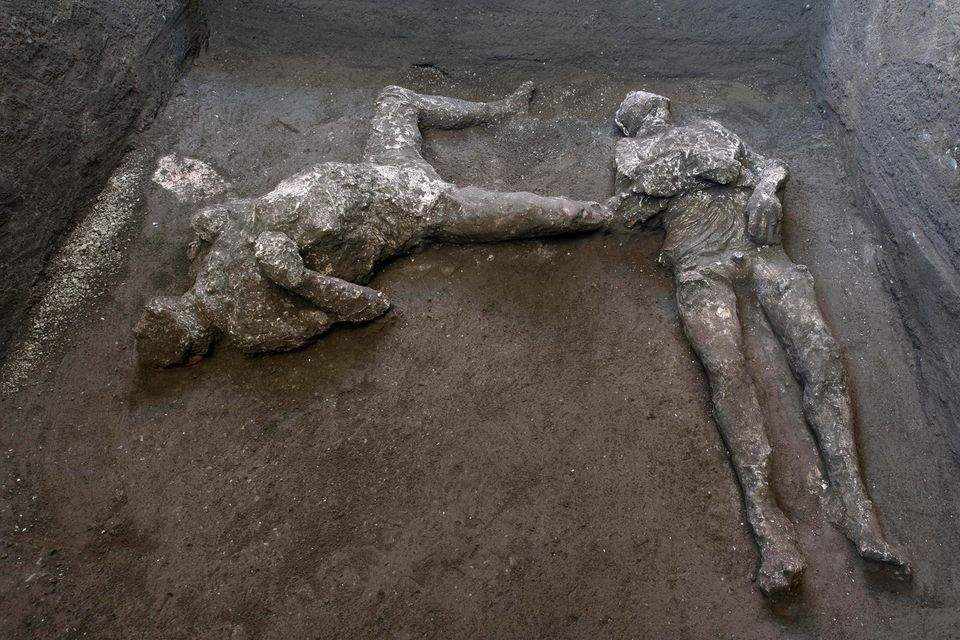The discovery in the excavations of Pompeii, in the locality of Civita Giuliana, of the bodies of two ancient Pompeians swept away by the fury of the eruption of Vesuvius in 79 A.D. has been defined, as usual, as an “extraordinary discovery”: this is the exact expression used by the minister of cultural heritage, Dario Franceschini, to present the discovery. But not only that: in several newspapers (newspapers, national TV stations), as well as on the web, the news was presented with headlines saying that “intact bodies” of the two fugitives were found in Pompeii. Of course, these are not intact bodies: those who presented the find in this way probably looked at the photograph of the casts of the victims, imagining that they were indeed the bodies of the two unfortunate Pompeians. And the misconception continued to circulate for a long time. And again: the fact that one of the two victims had vertebral crushes probably due to heavy labor (perhaps he was a slave) led to a particular reconstruction, launched by the MiBACT statement (but not the Park’s), that the two victims were the slave and his master.
Archaeologists at the Pompeii Archaeological Park, however, did no more than make casts of the remains of the two men found under a layer of hardened ash in a compartment of the villa’s cryptoporticus. This is a technique, developed in the second half of the nineteenth century by archaeologist Giuseppe Fiorelli (Naples, 1823 - 1896), by which the voids left by the decomposition of the organic matter of the bodies were filled under cinerite, or solidified ash (we explained it briefly on these pages as well). In short, can we clarify well what was found in Pompeii and why it makes no sense to talk about “intact bodies”? And most importantly: can we really talk about a sensational discovery? To get answers to these questions, we caught up with Professor Luciana Jacobelli, archaeologist, professor of Archaeological Research Methodology at the University of Molise, and among the leading experts on Pompeian archaeology.
“The real problem,” says Jacobelli, “is having considered the news as a scoop when in fact it is fake news, ridiculous news, because anyone who has worked in Pompeii has found or made casts or found human or animal remains. I personally made four casts in Pompeii, but I never dreamed of alerting the press. Casts have been made since 1863, and there are more than a thousand in Pompeii: so I don’t see where the particularity lies. Moreover, from the pictures I have seen, part of these casts is definitely fake, because some of the ash covering the cast had already been opened. To really have it intact you cannot remove the ash that covers the cast, because when you pour the plaster you are going to fill the void left by the decomposed body, however, if you already open a piece of this body then with the cast you make it fake again, because there is no longer what covered it. So actually already these casts are strange. I don’t see the exceptionality of the find: someone should explain it ... the cast is always made in the same way, that is, with plaster according to the technique accomplished in the 19th century by archaeologist Giuseppe Fiorelli.”
“Another thing that astounds me,” the archaeologist continues, “is the creation around this find of the anecdote of the master and the slave: anecdotes that date back to the nineteenth century, when it was the janitors who acted as guides who told them to captivate the attention of the tourist. Like the matron who was allegedly found in the gladiator barracks: a story made up to tell that women loved gladiators and this matron allegedly ran during the eruption to meet the gladiator. These are ridiculous things, there is no scientificity in this story of the master and the slave, these are things invented just to sensationalize archaeology. Social media is full of these little stories that ridicule the subject. To say that one body belonged to an adult and the other to a young person one must first study the bones, but if the bones have been studied first the cast cannot come. The cast is made without seeing the skeleton, since the latter is encased in plaster.”
The risk of too much sensationalism about Pompeii, Jacobelli believes, is to overshadow other archaeological sites, which also would need more care. “The problem,” Jacobelli concludes, “is that these reports seem to be the result of speculation, they are misleading, and this is not good for either archaeology or serious popularization. It is just a way to draw attention always and only to Pompeii. That there are then countless archaeological sites that are wonderful but literally falling apart (lately I have seen Cerveteri in disastrous condition) is of no interest to anyone. There is now only Pompeii. Even the press should be asking questions, but instead it just gives the news, and that is serious.”
Pictured: casts from the latest finds last week.
 |
| Extraordinary discoveries or ridiculous discoveries? What no one tells you about Pompeii |
Warning: the translation into English of the original Italian article was created using automatic tools. We undertake to review all articles, but we do not guarantee the total absence of inaccuracies in the translation due to the program. You can find the original by clicking on the ITA button. If you find any mistake,please contact us.